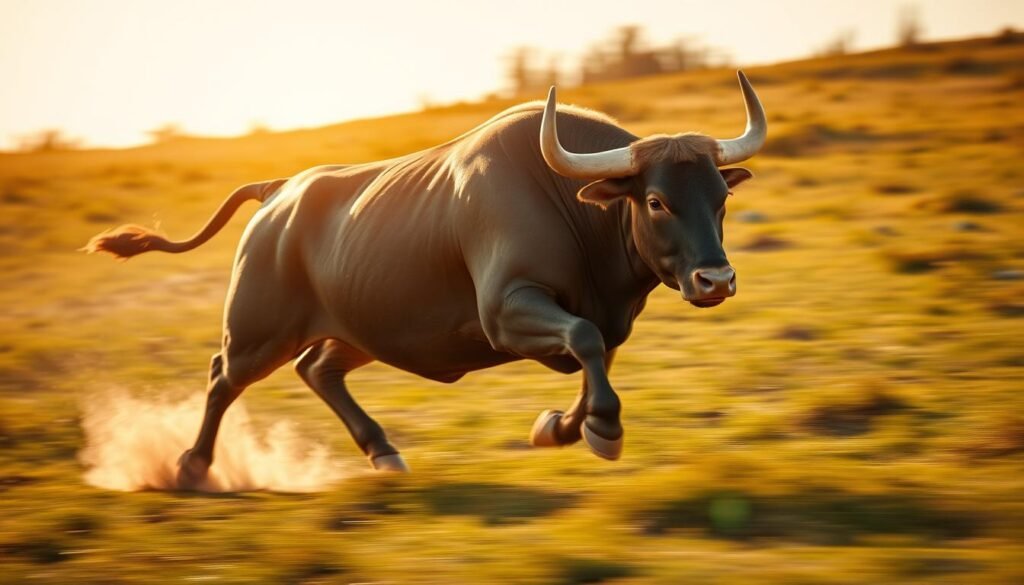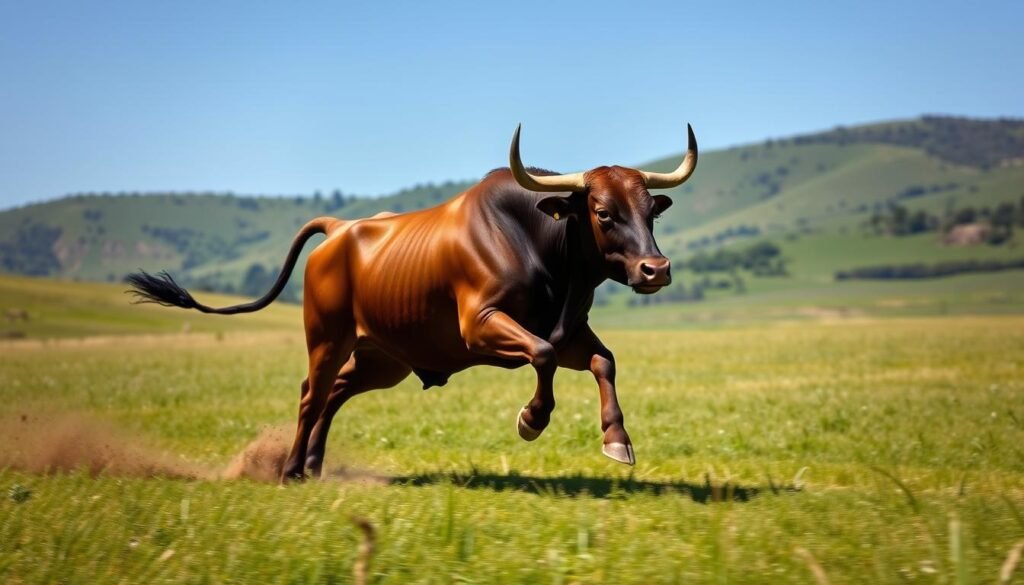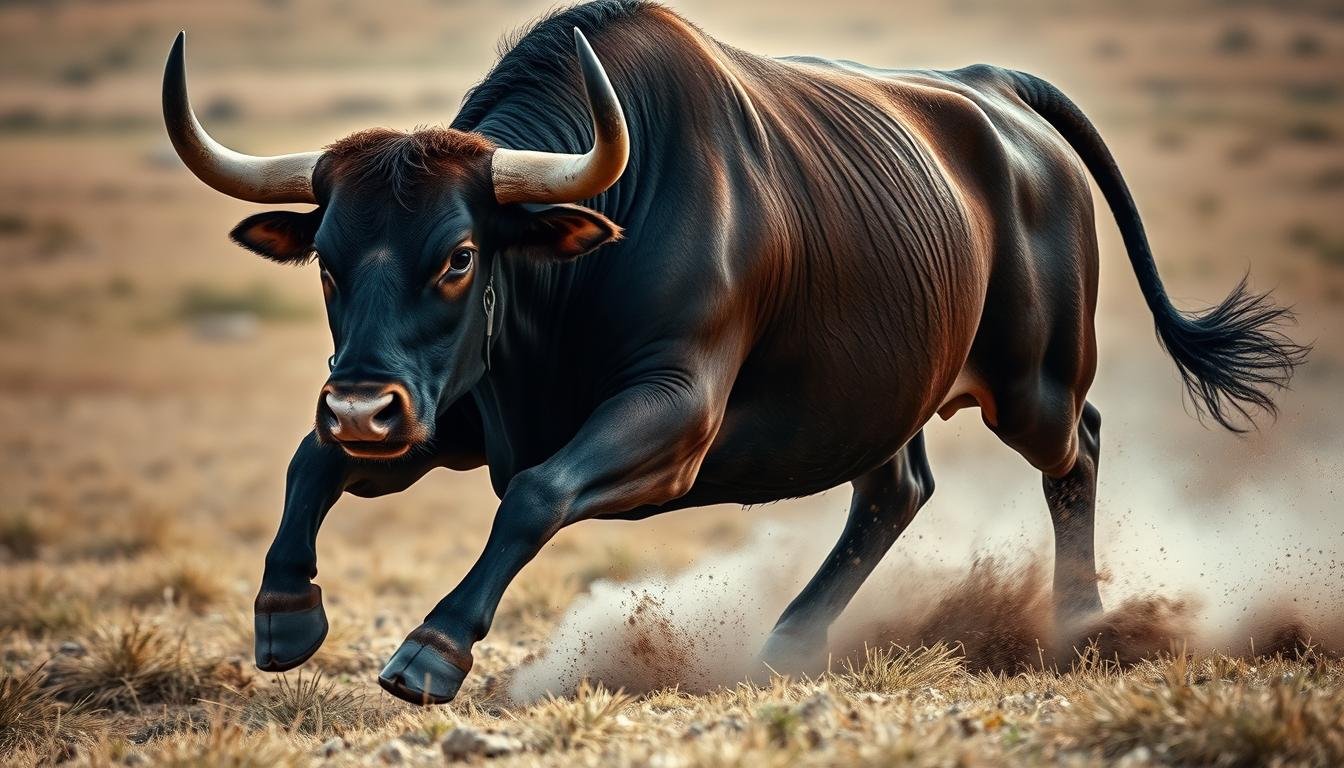Bulls have amazed people for centuries with their speed and power. These majestic creatures showcase their abilities in events like Pamplona’s Running of the Bulls. But how fast can a bull really run?
Let’s explore the world of bull running and uncover some fascinating facts. We’ll look at the science behind their speed and learn about impressive records. Discover what makes these formidable animals so fast and agile.
Key Takeaways
- Bulls are remarkably fast and can reach impressive speeds, rivaling even the fastest land animals.
- Various factors, such as breed, age, and environmental conditions, can influence a bull’s running speed.
- Understanding the science behind bull speed, including their anatomy and physiology, provides valuable insights into their athletic prowess.
- Historical and modern speed records showcase the remarkable capabilities of these powerful creatures.
- Bull running events around the world, such as the iconic Running of the Bulls in Pamplona, demonstrate the thrill and excitement surrounding these impressive animals.
Understanding Bull Speed: An Overview
Bulls are known for their impressive athletic abilities. These powerful creatures showcase remarkable bull running pace and cattle agility. Let’s explore the key factors that shape their running prowess.
Basic Speed Metrics and Measurements
Measuring bull speed is a complex task. Distance, terrain, and environment can affect recorded speeds. Bull running speed is typically measured in miles per hour or meters per second.
Factors Affecting Bull Running Speed
- Breed and genetic factors: Different breeds of bulls may exhibit varying levels of bull running pace and cattle agility due to their unique genetic makeup.
- Age and physical condition: Younger, healthier bulls generally demonstrate greater livestock athletic abilities compared to older or injured animals.
- Environmental conditions: Terrain, weather, and other external factors can significantly impact a bull’s running speed and performance.
Speed Comparison with Other Animals
Comparing bull speed to other fast-moving animals offers valuable perspective. Bulls are impressive runners, but may not be the fastest among livestock.
Their speed relative to other species highlights the cattle agility of these remarkable creatures. Understanding this comparison provides insights into bulls’ livestock athletic abilities.
The Science Behind Bull Running Capabilities
Bulls possess remarkable speed and agility due to their unique physiology. Their bull physiology enables impressive bovine athletic prowess. From muscular build to cardiovascular adaptations, bulls have physical attributes for incredible running speeds.
A bull’s muscular system is key to its running abilities. They have many fast-twitch muscle fibers for explosive power and quick acceleration. These fibers generate immense force, propelling bulls forward at high speeds.
Bulls also have efficient cardiovascular systems. Large hearts and powerful circulation pump oxygen-rich blood throughout their bodies. This keeps their energy levels high during intense activity.
The unique energy metabolism of bulls is crucial for their speed. They excel at converting fat and carbs into fuel for quick movements. This helps them maintain performance during chases or events.
| Physiological Trait | Contribution to Bull Running Capabilities |
|---|---|
| Muscle Fiber Composition | High proportion of fast-twitch muscle fibers for explosive power |
| Cardiovascular System | Efficient blood circulation and oxygen delivery to working muscles |
| Energy Metabolism | Effective conversion of stored energy sources to fuel dynamic movements |
These physiological adaptations work together in bulls. They allow for impressive bovine athletic prowess and incredible speeds. This combination of traits amazes spectators around the world.
Maximum Speed Records: How Fast Can a Bull Run
Bulls are known for their incredible speed and power. Their top sprint speeds have fascinated enthusiasts and researchers for years. Let’s explore the records of these majestic creatures.
Historical Speed Records
Bull sprint speeds have been documented throughout history. In 1865, a Spanish fighting bull named El Dictador achieved an amazing feat. He was clocked at 35 miles per hour (56 kilometers per hour) during a bullfight.
Modern Speed Measurements
Today, technology allows for more accurate bull sprint speed measurements. Advanced tracking systems have recorded impressive velocities. Some bulls have reached speeds up to 40 miles per hour (64 kilometers per hour).
Speed Variations Among Bull Breeds
Bull sprint speed can vary greatly among different breeds. Spanish fighting bulls are often considered the fastest. Their speeds can rival those of the world’s swiftest land animals.
Domestic bulls used for rodeos or farming may be slightly slower. However, they still maintain an impressive level of athleticism. Their power and speed continue to amaze spectators.

Bull Anatomy and Its Impact on Speed
Bulls are incredibly fast and agile due to their unique anatomy. Their specialized physiology has evolved over centuries. This optimization enhances their speed and maneuverability.
A bull’s leg structure is key to its speed. They have muscular legs with an impressive range of motion. Their large hooves provide excellent traction and stability for quick acceleration.
The bull physiology includes a low center of gravity. This feature improves their stability and balance. It’s crucial for maintaining high speeds during movement.
Bulls are known for their impressive muscle mass. This translates into raw power and explosiveness. Their strong, compact build allows them to generate and sustain high speeds easily.
Skeletal adaptations contribute to a bull’s athletic abilities. Their bones and joints are reinforced to handle stress. This allows for sudden starts, stops, and direction changes.
| Anatomical Feature | Impact on Bull Speed |
|---|---|
| Leg Structure | Powerful, muscular legs with a wide range of motion for long, forceful strides and quick changes in direction. |
| Body Composition | Impressive muscle mass and low body fat percentage, enabling explosive speed and power. |
| Skeletal Adaptations | Reinforced bones and joints that can withstand the high forces generated during high-speed movements. |
The bull physiology is a marvel of nature. It allows these animals to achieve impressive speeds. Understanding this helps us appreciate their remarkable athletic abilities.
Different Bull Breeds and Their Speed Capabilities
Bulls come in various breeds, each with unique speed abilities. From agile fighting bulls to powerful domestic bulls, their capabilities fascinate many. Let’s explore the world of bull speed and agility.
Fighting Bulls vs. Domestic Bulls
Fighting bulls are known for their exceptional bull speed. They’re bred for quick charges and swift movements in bullfighting events. Domestic bulls, used in farming, may not match their agility.
However, these agricultural bovines still show impressive speed when needed. Their power and strength make them valuable for various farm tasks.
Spanish Fighting Bulls
Spanish fighting bulls are among the most celebrated breeds worldwide. They’re famous for their lightning-fast reflexes and remarkable ground-covering speed. These majestic creatures hail from the Iberian Peninsula.
Their bull speed shines in Pamplona’s Running of the Bulls festival. Spectators witness awe-inspiring displays of agility during this iconic event.
American Rodeo Bulls
American rodeo bulls have their own niche in cattle agility. They’re bred for explosive speed and incredible strength. These powerful bovines showcase their skills in various rodeo events.
From bull-riding competitions to heart-pounding bull runs, they captivate audiences worldwide. Their raw speed and athleticism make them true American icons.
Bull breeds offer a rich tapestry of speed capabilities. Each breed contributes uniquely to our fascination with these remarkable animals.
| Bull Breed | Speed Characteristics | Notable Events |
|---|---|---|
| Spanish Fighting Bulls | Exceptional agility and speed, able to cover ground quickly | Running of the Bulls in Pamplona |
| American Rodeo Bulls | Explosive speed and incredible strength | Rodeo competitions and bull runs |
| Domestic Bulls | May not possess the same level of agility as fighting bulls, but still exhibit impressive speed and power | Agricultural and farming activities |
Environmental Factors Affecting Bull Speed
The environment greatly impacts a bull’s running speed. Bulls are sensitive to their surroundings. Terrain, climate, and weather can affect their performance.
Surface type is crucial for bull speed. Bulls excel on firm, even ground with good traction. Mud or loose soil can slow them down. Steep or uneven terrain challenges their agility.
- Terrain: Bulls perform best on flat, sturdy surfaces with good footing.
- Climate: Extreme temperatures, whether hot or cold, can tax a bull’s stamina and speed.
- Weather: Rain, wind, and other environmental conditions can affect a bull’s running ability.
Bulls adapt to different environments. Mountain-raised bulls may develop stronger lungs. Those from hot climates might regulate body temperature better during sprints.
| Environmental Factor | Impact on Bull Speed |
|---|---|
| Terrain | Firm, even ground provides the best traction for bull running velocity. Soft, uneven surfaces can hinder acceleration and top speed. |
| Climate | Extreme temperatures, whether hot or cold, can tax a bull’s stamina and livestock athletic abilities. |
| Weather | Rain, wind, and other environmental conditions can affect a bull’s running performance. |
Understanding these factors helps us appreciate bulls’ adaptability. It shows their incredible physical prowess in various conditions.

Bull Running Techniques and Patterns
Bulls show amazing speed and agility. Their running techniques and patterns are vital to understand. They mix explosive acceleration with long sprints, making them formidable in the arena.
Acceleration and Sprint Patterns
Bulls are known for their fast acceleration. They can reach top bull running pace in seconds. This speed helps them survive in the wild and perform in events.
Their powerful hindquarters let them surge forward with great force. This leaves spectators in awe of their strength and speed.
The bull sprint speed of these animals is just as impressive. Bulls can keep their top speed for long distances. This shows their great endurance and stamina.
Distance and Endurance Factors
- Cardiovascular Fitness: Bulls have a strong heart system. This helps them run fast for long times.
- Muscular Strength: Bulls’ powerful muscles, especially in their rear, help maintain sprint pace.
- Skeletal Structure: Bulls’ bones and joints are built for efficient, long running.
- Respiratory System: Bulls breathe very well. This gives their muscles oxygen during long sprints.
Bulls’ running skills show their amazing abilities. Their speed, power, and stamina continue to amaze people worldwide.
Safety Considerations When Around Running Bulls
Safety is vital when dealing with bull running. The bull running velocity and bull speed can be dangerous. It’s crucial to stay informed and alert.
Keeping a safe distance is key. Spectators should watch from designated areas. Participants must follow strict safety rules and organizers’ instructions.
- Avoid getting too close to the animals, as their bull running velocity can be unpredictable and their bull speed can catch even the most agile individuals off guard.
- Be aware of your surroundings and stay alert, as bulls may change direction or charge unexpectedly.
- Wear appropriate protective gear, such as helmets and padding, if you’re participating in a bull-related event.
- Follow the instructions of event staff and security personnel to ensure your safety and that of others.
The bull running velocity and bull speed are thrilling but dangerous. Respect the animals and follow safety guidelines. Use common sense to stay safe.
Prioritize safety to enjoy these majestic creatures. Be mindful of risks to minimize harm. Responsible participation and awareness are key to a safe event.
Famous Bull Running Events Worldwide
Bull running thrills people worldwide. The Running of the Bulls in Pamplona is the most famous event. This yearly festival, called Sanfermines, has amazed audiences for centuries.
It showcases Spanish fighting bulls’ speed and power. The bulls charge through Pamplona’s historic streets, creating an unforgettable spectacle.
Running of the Bulls in Pamplona
Pamplona’s bull run happens in July. It attracts thousands of thrill-seekers and spectators from across the globe.
Runners sprint through a set course, trying to outpace the charging bulls. These powerful animals can reach speeds up to 35 miles per hour.
The event tests human-animal interaction limits. It’s become a global phenomenon, highlighting how fast can a bull run.
Other Notable Bull Running Festivals
Several other bull running events showcase these majestic animals’ athletic prowess. They display impressive bull fitness and speed.
The National Finals Rodeo in Las Vegas features high-speed bull riding competitions. Professional cowboys attempt to stay on bucking bulls for as long as possible.
Mexico’s Torreón Bull Run is another popular event for thrill-seekers. These festivals celebrate cultural heritage and the human-bull connection.
